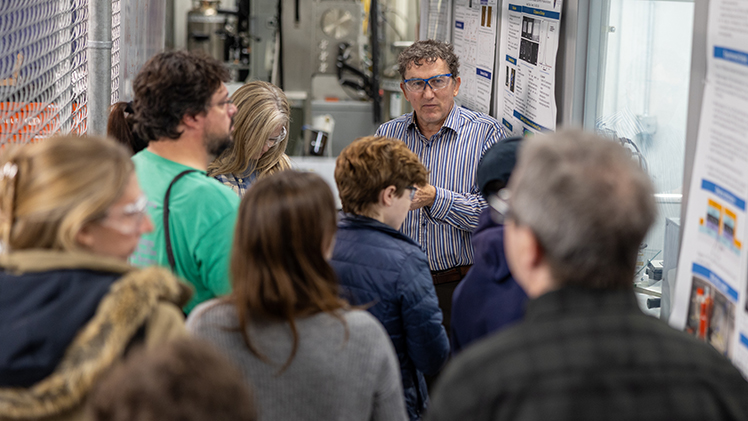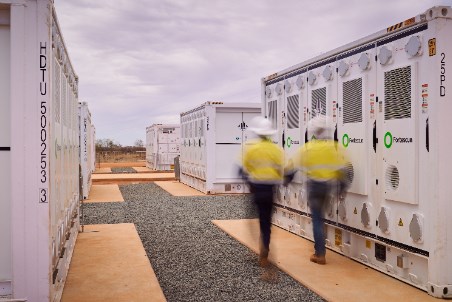Lake Erie Center, Wright Center for Photovoltaics Innovation and Commercialization Welcome Environmental Journalists – UToledo News

University of Toledo Research Initiatives Aligned with Sustainable Development Goals
Event Summary: “Troubled Waters” Journalism Workshop
On November 21, the University of Toledo hosted a delegation of over 20 journalists for a workshop titled “Troubled Waters: The Fate of the Great Lakes in a Shifting Federal Landscape.” Organized by the Institute for Journalism & Natural Resources, the event highlighted the university’s research contributions toward achieving key United Nations Sustainable Development Goals (SDGs). Journalists visited two primary research centers to observe work directly impacting environmental sustainability.
Institutional Contributions to Global Sustainability Targets
Lake Erie Center: Advancing Water-Related SDGs
The Lake Erie Center conducts research on local environmental conditions with global applications for aquatic ecosystems, directly supporting goals for clean water and the protection of life below water.
Key Research Areas:
- Analysis of harmful algal blooms.
- Monitoring and mitigation of invasive species.
- Investigation of salt pollution in aquatic environments.
Alignment with Sustainable Development Goals:
- SDG 6: Clean Water and Sanitation: Research into pollutants and algal blooms contributes to the protection and restoration of water-related ecosystems.
- SDG 14: Life Below Water: Studies on invasive species and ecosystem health are fundamental to conserving and sustainably using freshwater resources.
Wright Center for Photovoltaics Innovation and Commercialization: Fostering Energy-Related SDGs
The Wright Center is dedicated to advancing solar energy technology, a critical component in the global strategy for affordable, clean energy and climate action.
Core Objectives:
- Accelerating technological advancements in the photovoltaic industry.
- Reducing the cost of solar energy production.
- Fostering innovation in renewable energy solutions.
Alignment with Sustainable Development Goals:
- SDG 7: Affordable and Clean Energy: The center’s work aims to increase the share of renewable energy in the global energy mix by making solar power more efficient and cost-effective.
- SDG 13: Climate Action: By driving innovation in solar technology, the center contributes directly to climate change mitigation efforts.
- SDG 9: Industry, Innovation, and Infrastructure: The center supports the development of resilient and sustainable infrastructure through its focus on the renewable energy industry.
1. SDGs Addressed in the Article
The article highlights work and discussions relevant to several Sustainable Development Goals (SDGs), primarily focusing on environmental research, clean energy, and education. The key SDGs identified are:
- SDG 6: Clean Water and Sanitation
- SDG 7: Affordable and Clean Energy
- SDG 9: Industry, Innovation and Infrastructure
- SDG 13: Climate Action
- SDG 14: Life Below Water
2. Specific Targets Identified
Based on the activities described, specific targets under the identified SDGs can be pinpointed:
SDG 6: Clean Water and Sanitation
- Target 6.3: Improve water quality by reducing pollution. The Lake Erie Center’s research into “algal blooms” and “salt pollution” directly addresses the need to understand and mitigate water pollution to improve water quality.
- Target 6.6: Protect and restore water-related ecosystems. The Center’s focus on the environmental conditions of Lake Erie and its work on issues like “invasive species” contribute to the protection and restoration of this major aquatic ecosystem.
SDG 7: Affordable and Clean Energy
- Target 7.2: Increase substantially the share of renewable energy in the global energy mix. The Wright Center for Photovoltaics Innovation and Commercialization is a “solar energy-focused research center” dedicated to “accelerating the growth of the photovoltaic industry,” which directly supports increasing the share of solar energy.
- Target 7.a: Enhance international cooperation to facilitate access to clean energy research and technology. The Center’s mission of “driving advancements in technology, reducing costs and fostering innovation” in photovoltaics aligns with this target of improving clean energy technology.
SDG 9: Industry, Innovation and Infrastructure
- Target 9.5: Enhance scientific research, upgrade the technological capabilities of industrial sectors. Both the Lake Erie Center and the Wright Center are examples of institutions conducting scientific research to address environmental challenges and advance technology (“driving advancements in technology”) in the renewable energy sector.
SDG 13: Climate Action
- Target 13.3: Improve education, awareness-raising and human and institutional capacity on climate change mitigation. The workshop itself, “Troubled Waters: The Fate of the Great Lakes,” which brings journalists to research centers, is a direct effort to raise awareness and educate key communicators on environmental issues closely linked to climate change.
SDG 14: Life Below Water
- Target 14.1: Prevent and significantly reduce marine pollution of all kinds. The research on “algal blooms” (nutrient pollution) and “salt pollution” in Lake Erie, a major freshwater ecosystem, is directly relevant to reducing pollution from land-based activities that affect large bodies of water.
- Target 14.2: Sustainably manage and protect marine and coastal ecosystems. The work of the Lake Erie Center to understand threats like “invasive species” contributes to the knowledge base needed to sustainably manage and protect large aquatic ecosystems.
3. Indicators Mentioned or Implied
The article does not mention specific quantitative indicators, but it implies several that could be used to measure progress towards the identified targets:
Implied Indicators for Water Quality (SDG 6 & 14)
- Water quality measurements: The research on “salt pollution” implies measuring salinity levels. The study of “algal blooms” implies monitoring nutrient concentrations (like phosphorus and nitrogen) and chlorophyll-a levels in the water.
- Biodiversity health: The mention of “invasive species” implies indicators related to the prevalence and impact of non-native species versus the health of native populations in the Lake Erie ecosystem.
Implied Indicators for Clean Energy (SDG 7)
- Technological efficiency: The goal of “driving advancements in technology” in photovoltaics implies measuring the conversion efficiency of solar cells developed at the center.
- Cost of renewable energy: The aim of “reducing costs” for the photovoltaic industry implies an indicator like the Levelized Cost of Energy (LCOE) for solar power or the manufacturing cost per watt of solar panels.
Implied Indicators for Innovation and Awareness (SDG 9 & 13)
- Research output: The existence of two major research centers (Lake Erie Center and Wright Center) implies indicators such as the number of scientific publications, patents filed, or research projects undertaken.
- Public outreach and engagement: The workshop for “more than 20 journalists” from outlets like “The New York Times” implies an indicator related to the number of people reached or articles published as a result of the event, measuring the success of awareness-raising efforts.
4. Summary Table of SDGs, Targets, and Indicators
| SDGs | Targets | Indicators (Implied from Article) |
|---|---|---|
| SDG 6: Clean Water and Sanitation | 6.3: Improve water quality by reducing pollution. 6.6: Protect and restore water-related ecosystems. |
– Measurements of water pollutants (e.g., salt, nutrients causing algal blooms). – Health and status of the Lake Erie ecosystem. |
| SDG 7: Affordable and Clean Energy | 7.2: Increase the share of renewable energy. 7.a: Facilitate access to clean energy research and technology. |
– Advancements in solar cell efficiency. – Reduction in the cost of photovoltaic technology. |
| SDG 9: Industry, Innovation and Infrastructure | 9.5: Enhance scientific research and encourage innovation. | – Number of research projects and publications from the Lake Erie and Wright Centers. – Technological advancements and innovations in photovoltaics. |
| SDG 13: Climate Action | 13.3: Improve education and awareness-raising on climate change. | – Number of journalists and media outlets participating in the workshop. – Reach of media coverage resulting from the event. |
| SDG 14: Life Below Water | 14.1: Reduce marine pollution from land-based activities. 14.2: Protect and restore marine and coastal ecosystems. |
– Levels of nutrient and salt pollution in Lake Erie. – Data on the prevalence and impact of invasive species. |
Source: news.utoledo.edu
What is Your Reaction?
 Like
0
Like
0
 Dislike
0
Dislike
0
 Love
0
Love
0
 Funny
0
Funny
0
 Angry
0
Angry
0
 Sad
0
Sad
0
 Wow
0
Wow
0





















































.jpg.webp?itok=0ZsAnae9#)



























